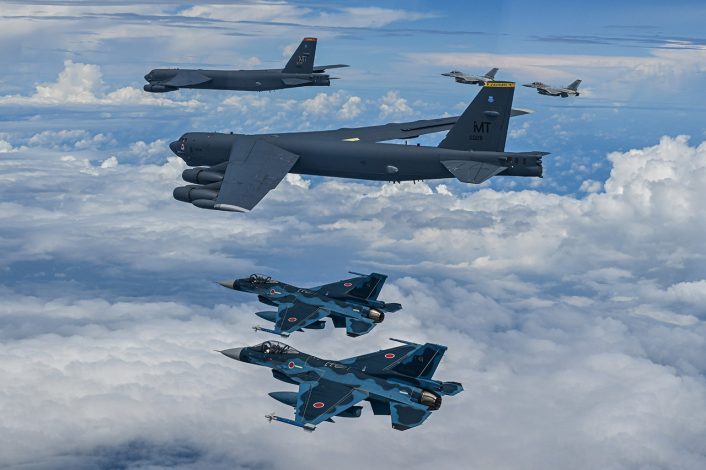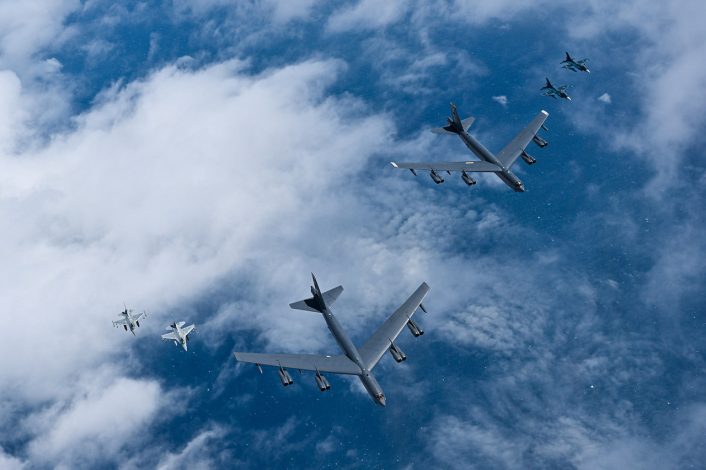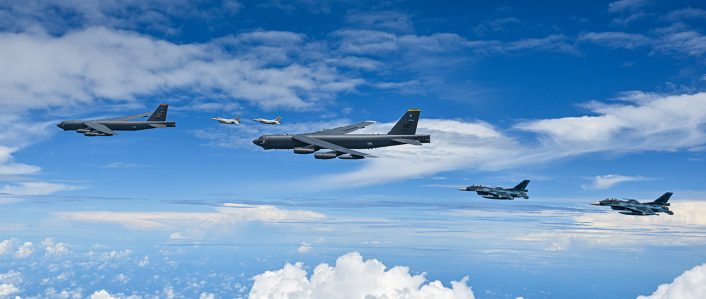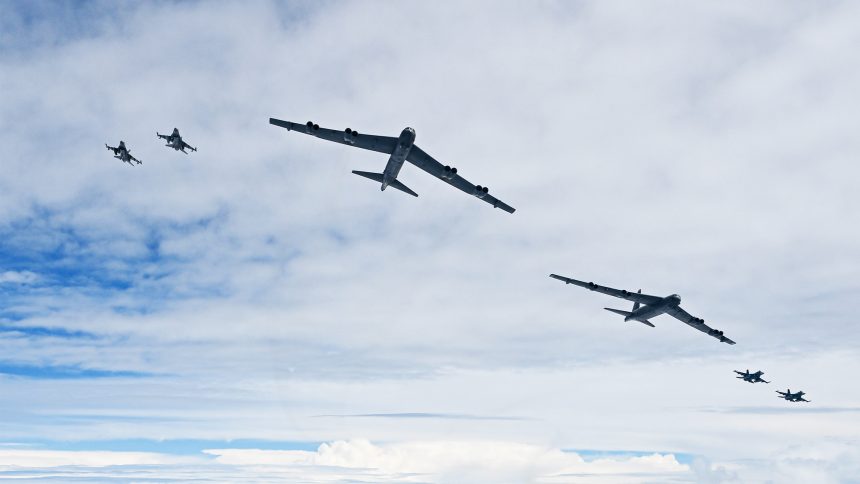U.S. Air Force B-52s deployed to Andersen AFB, Guam, linked with Japanese Mitsubishi F-2 and South Korean KF-16 Fighting Falcon fighter aircraft while operating in the Pacific region on Jul. 11, 2025.
According to the U.S. Air Force, the escort mission marked the third trilateral flight between the three nations over the course of 2025, with the first taking place in January. Other bilateral exercises have also taken place, including a precision strike drill featuring USAF B-1B Lancers and Republic of Korea Air Force (ROKAF) F-15s and KF-16s.
The Japan Air Self-Defense Force (JASDF) contributed two Mitsubishi F-2s for the escort – a locally built derivative of the F-16 – while the ROKAF sent KF-16 Fighting Falcons to accompany the U.S. jets.
1/ This is the third trilateral flight of 2025 between the three nations, to include a bomber escort flight in January, while a trilateral flight in June refined defensive counter-air training. https://t.co/Jxc2suNRNx pic.twitter.com/ERg6AGdqZU
— Guy Plopsky (@GuyPlopsky) July 12, 2025
Multiple B-52s from Minot Air Force Base, North Dakota, deployed to Andersen Air Force Base, Guam, earlier this month to commence a Bomber Task Force deployment. Joint training missions with allies are a key part of these deployments, which take place in both the European and Pacific theatres.

Their frequency has increased in recent years, with a previous B-52 detachment to Guam only wrapping up at the end of May, and a B-1B deployment to Japan took place in April. Alongside these, B-52s remain deployed to Diego Garcia where they replaced previously deployed B-2 Spirits.
A USAF press release said the following about the trilateral sortie: “Our steadfast commitment fosters trust, strengthens cooperation, and reinforces the collective will and ability to maintain security and stability in the Indo-Pacific.” Permanent rotations of strategic bombers to Guam were maintained by the USAF for over a decade until 2020, when the routine switched to the current regular BTF deployments.

Based on the serial numbers as well as the presence of ‘shark fins’, we can tell that both of the bombers involved in this flight were from the nuclear capable fleet. Though interesting to note, it should be stressed that both nuclear capable and non-nuclear capable B-52s regularly take part in these kinds of missions.
Political Context
In wider geopolitical terms, the primary ‘opponent’ that U.S. deployments to the Indo-Pacific aims to counter is China. Though, for both South Korea and Japan an arguably more pressing concern is often North Korea. U.S. strategic bomber sorties over the Korean peninsula have frequently taken place during times of increased diplomatic tensions – such as after North Korean missile tests – and have sometimes provoked retaliatory threats from the one-party state.
Indeed, responding to this event, the Korean Central News Agency (KCNA) – North Korea’s state news agency – published a statement on behalf of government officials condemning “irresponsible acts” and “threatening military actions”, which the nation claims heightens the level of tension on the peninsula. “It is our just sovereign right to take countermeasures against provocative military actions such as the moves to strengthen the multilateral military alliance threatening the security of the region and the joint military drills with clear aggressive character,” the statement adds.

The first trilateral exercise of this kind between the U.S., Japan, and South Korea, took place in 2023. Though sharing concern regarding their neighbor, relations between Japan and South Korea have historically been rocky due to lingering hostilities regarding Japan’s thirty five year occupation of the Korean Peninsula between 1910 and 1945.
Annual trilateral exercises were agreed upon during an August 2023 summit between the nations’ respective leaders held at Camp David. The three nations additionally agreed to increase cooperation on missile defence, economic security, contingency planning, and more.
Since taking office for his second term, U.S. President Donald Trump has suggested he would like to normalise relations with North Korea. Notably, during his first term, Trump actually entered North Korea briefly while meeting Kim Jong Un at the Joint Security Area (JSA) on the border between the north and south.
June 30, 2019: President Donald Trump walked into North Korea and spoke to Kim Jong-Un.
He became the first sitting U.S. president to visit that country.
pic.twitter.com/nULGe7XCgd
— Today in History (@HistoryNutOTD) June 30, 2025
However, other foreign policy goals have had to take priority with rapidly evolving situations in the Middle East and extensive back-and-forth negotiations with NATO allies and Ukraine regarding the state of affairs in Europe. Additionally complicating matters is North Korea’s staunch support for Russia in its invasion of Ukraine, which has seen North Korean troops directly deployed on the frontlines of the conflict.
Russian Foreign Minister Sergey Lavrov traveled to Pyongyang, North Korea’s capital, to meet with Kim Jong Un on Jul. 12, reaffirming the two nations’ “unconditional” support for each other. U.S. estimates in 2024 claimed that around 10,000 North Korean troops were thought to have been deployed to Russia. Earlier this month, reports emerged that North Korea’s contribution to the war could be bolstered with 25,000 to 30,000 more personnel.









